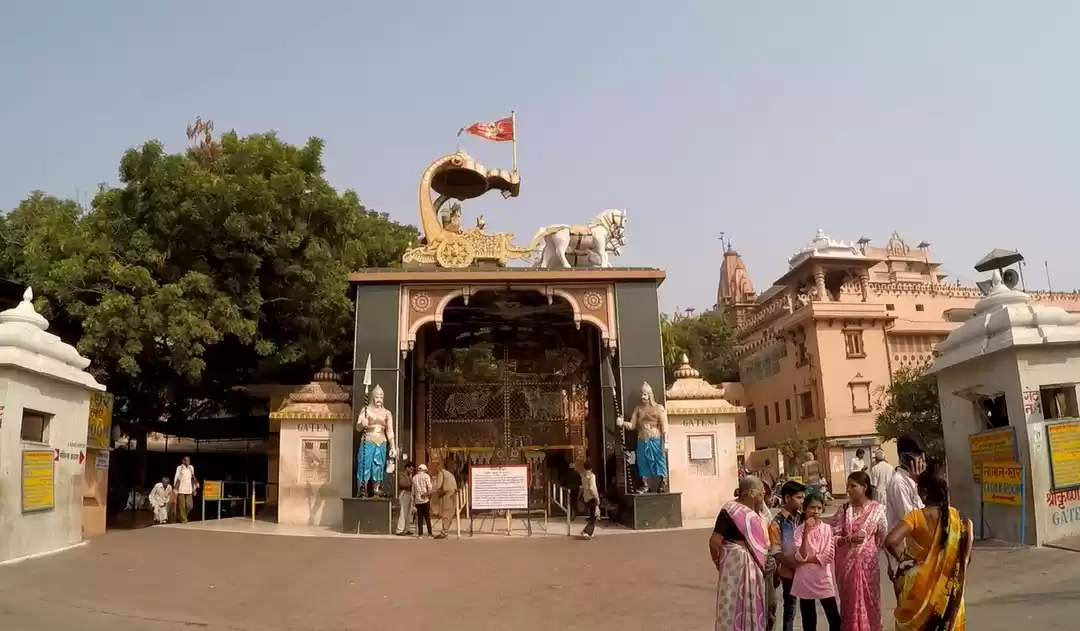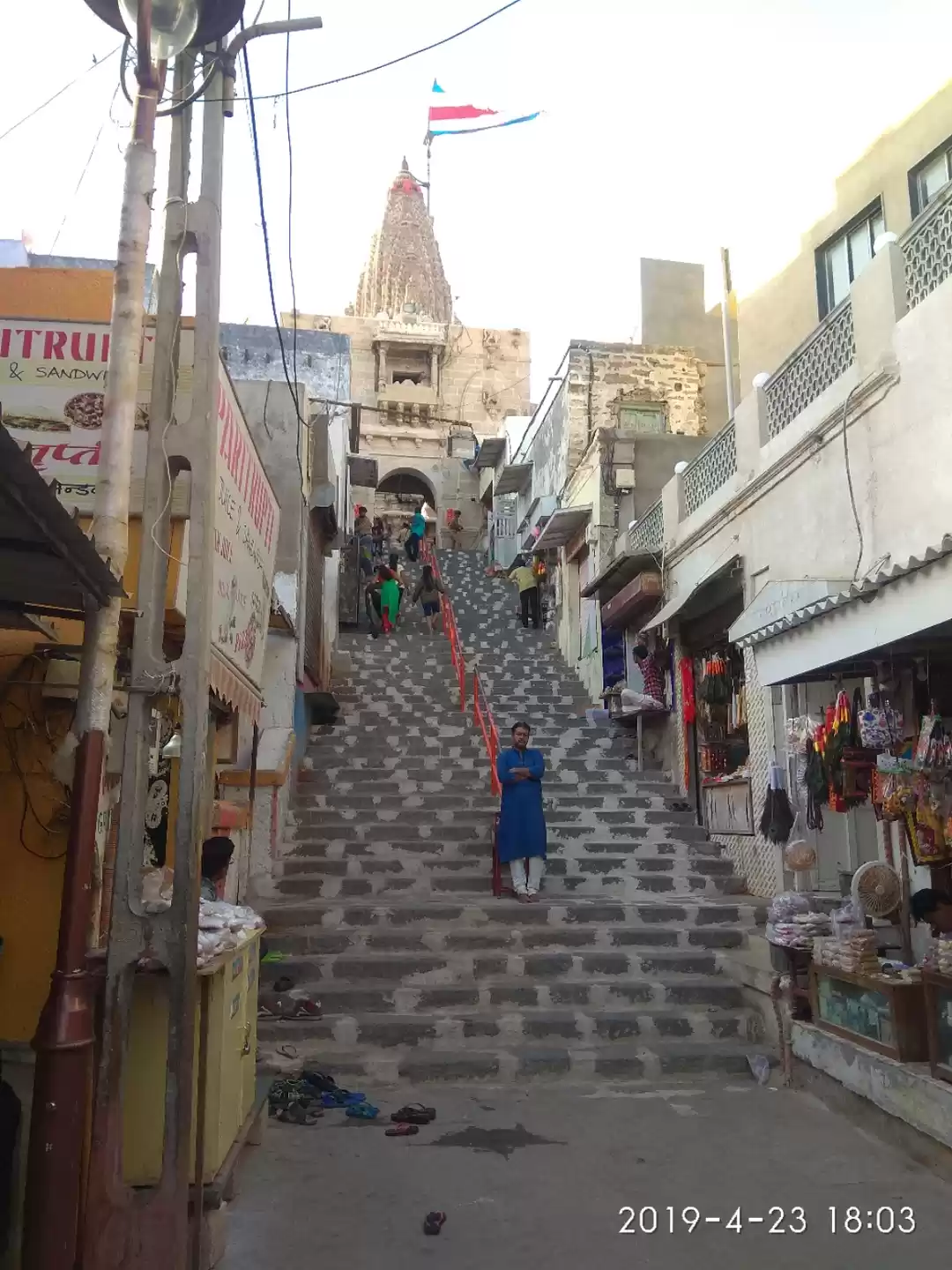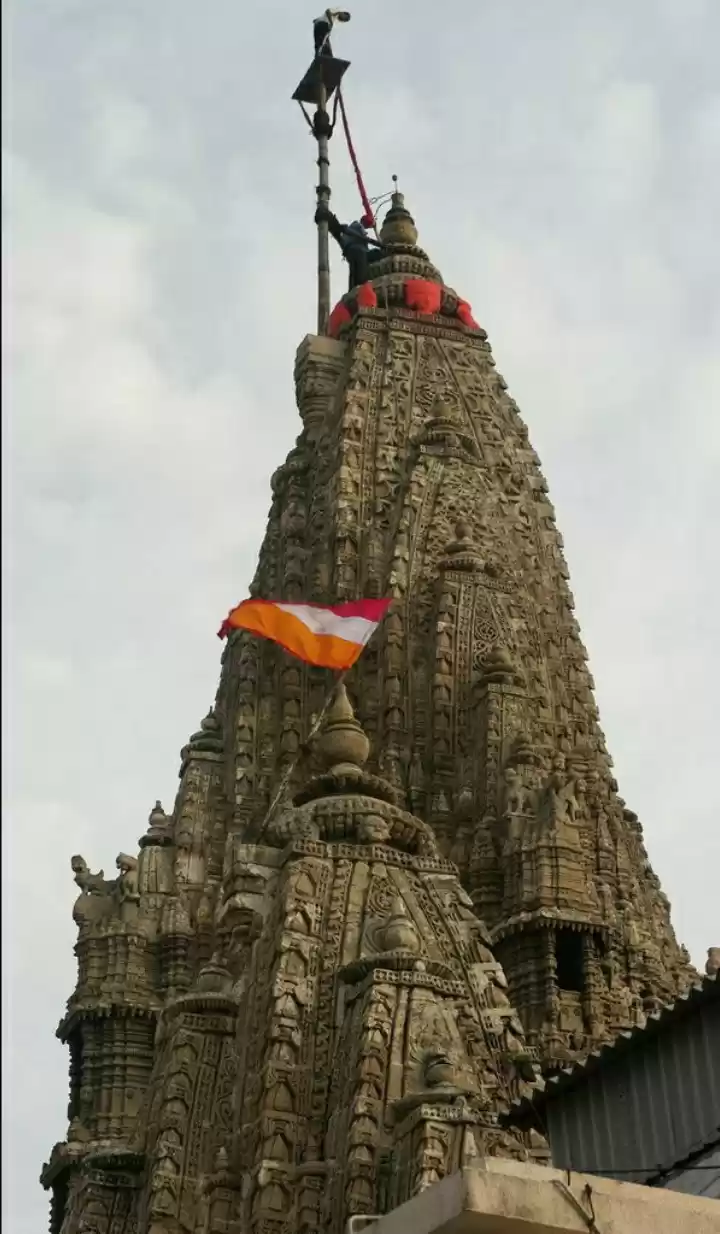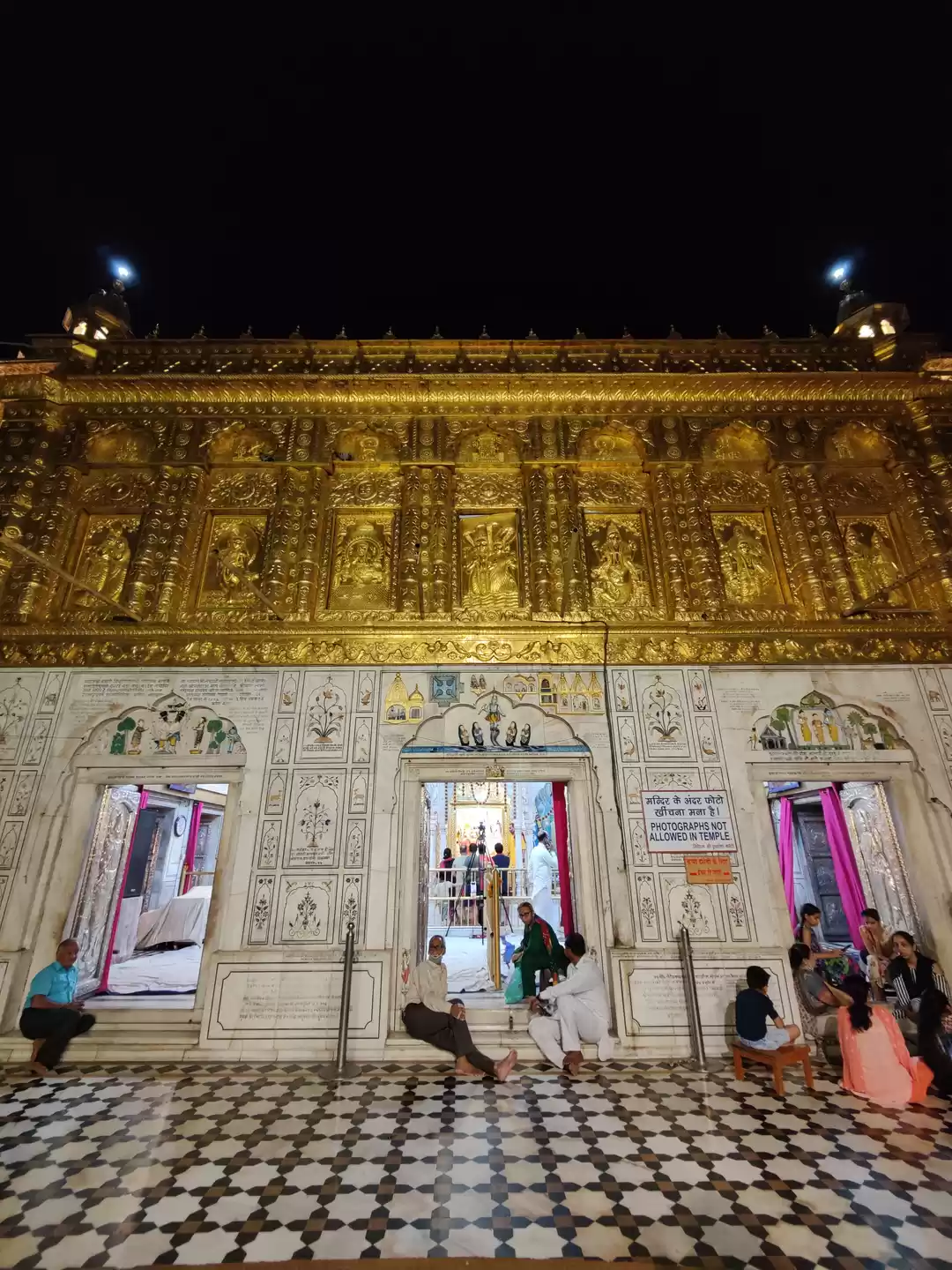Are you looking for a spiritual and cultural destination that will take you back to the ancient times of Lord Krishna and his divine love? If yes, then you must visit the Dwarkadheesh Temple Mathura, one of the most sacred and ancient temples dedicated to Lord Krishna, the eighth incarnation of Lord Vishnu, in Mathura, his birthplace. The temple is a magnificent and majestic structure that showcases the blend of Hindu, Islamic, and Rajasthani art and culture, and houses the idol of Lord Dwarkadhish and his consort Radharani, made of black and white marble respectively.
In this article, we will explore the history, architecture, idol, festivals and activities of the Dwarkadheesh Temple Mathura, as well as provide you with practical information on how to visit the temple, such as its timings, entry fee, location, phone and tour packages.
History of the Dwarkadheesh Temple Mathura

The history and origin of the temple and its idol are shrouded in legends and myths, but also supported by historical facts and evidence. According to the legend, Lord Krishna was born in Mathura, in a prison cell where his parents, Vasudeva and Devaki, were imprisoned by his uncle Kansa, the tyrant king of Mathura. Kansa had a prophecy that he would be killed by the eighth son of his sister Devaki, so he tried to kill all her children, but failed to do so. Lord Krishna was secretly taken to Vrindavan, a village near Mathura, where he grew up with his foster parents, Nanda and Yashoda, and his beloved Radharani.
The idol of Lord Dwarkadhish was brought from Dwarka to Mathura by a devotee named Vajranabha, the great-grandson of Lord Krishna, who installed it in a temple near the Yamuna river. The temple was built by Seth Gokuldas Parikh, a treasurer of the Gwalior province, in 1814, and he commissioned artists and craftsmen from Rajasthan to design and decorate the temple.
Architecture of the Dwarkadheesh Temple Mathura
The temple is a magnificent and majestic structure that showcases the blend of Hindu, Islamic, and Rajasthani art and culture. The temple is 25 meters high, 30 meters wide, and 40 meters long, and has a rectangular shape. The temple has three domes, four pillars, eight arches, twelve windows, sixteen doors, twenty-four balconies, and thirty-two railings. The temple is made of red sandstone, white marble, and yellow limestone, and has intricate carvings and paintings on its walls and ceilings. The temple resembles the temples of Dwarka and Nathdwara, and has a fusion of Hindu and Islamic architectural elements, such as lotus, peacock, and geometric patterns.
The temple has two floors, the ground floor and the first floor. The ground floor has the main hall, where the idol of Lord Dwarkadhish and Radharani is placed on a silver throne, and the devotees can offer their prayers and offerings. The first floor has the gallery, where the paintings and murals of the temple are displayed, depicting the life and deeds of Lord Krishna and his devotees. The paintings and murals depict scenes such as the birth of Lord Krishna, the killing of Kansa, the lifting of the Govardhan hill, the Ras Leela, the Kurukshetra war, and the Bhagavad Gita.
Idol of the Dwarkadheesh Temple Mathura
The idol of Lord Dwarkadhish and his consort Radharani is the main attraction and the soul of the temple. The idol is 2.5 meters high, 1.5 meters wide, and 0.5 meters thick, and has a standing posture, with Lord Dwarkadhish holding a flute in his right hand and Radharani holding a lotus in her left hand. The idol has a smiling expression, and is adorned with colourful clothes, jewels, and flowers.
The idol is made of black and white marble, representing the dark and fair complexion of Lord Krishna and Radharani respectively, and has gold and silver accessories, representing their divine and royal status. The idol is worshipped daily by the priests and the devotees, who perform various rituals and ceremonies, such as dressing, bathing, offering, and aarti.
Festivals of the Dwarkadheesh Temple Mathura
The temple is the center of various festivals and activities that celebrate the life and deeds of Lord Krishna and his devotees. The festivals are marked by colourful and vibrant decorations, costumes, processions, and performances, and attract thousands of pilgrims and tourists from all over the world. Some of the major festivals celebrated at the temple are:
Holi:
Holi is the festival of colours, joy, and love, celebrated in the month of March, on the full moon day of the Phalguna month of the Hindu calendar. The festival commemorates the victory of good over evil, and the love of Lord Krishna and Radharani. The festival is celebrated by throwing and applying colours, water, and flowers on each other, and singing and dancing to the tunes of Lord Krishna’s flute.
Janmashtami:
Janmashtami is the birthday of Lord Krishna, celebrated in the month of August or September, on the eighth day of the Krishna Paksha of the Bhadrapada month of the Hindu calendar. The festival celebrates the birth and the life of Lord Krishna, and his message of love, peace, and justice.
Hindola:
Hindola is the festival of swings, celebrated in the month of July or August, on the first day of the Shravana month of the Hindu calendar. The festival celebrates the playful and romantic mood of Lord Krishna and Radharani, and their enjoyment of the monsoon season. The festival is celebrated by decorating and swinging the idol of Lord Dwarkadhish and Radharani on a wooden or silver swing, and offering them various types of fruits, flowers, and sweets.
Activities of the Dwarkadheesh Temple Mathura
The temple offers various activities that visitors can do to experience the grace and blessings of Lord Dwarkadhish and Radharani, and to enjoy the beauty and charm of the temple and its surroundings. Some of the activities that visitors can do at the temple are:
1. Offering flowers, tulsi leaves and bhog: Visitors can offer flowers, tulsi leaves and bhog to the idol of Lord Dwarkadhish and Radharani, and express their love and devotion to them. The visitors can choose from a variety of flowers, such as roses, marigolds, jasmine, and lotus, and tulsi leaves, which are considered sacred by the Hindus. The visitors can also participate in the aarti ceremonies, where they can wave lamps, incense, and flowers to the idol, and receive the prasad, the blessed food, as a token of grace.
2. Admiring the carvings and paintings: Visitors can admire the carvings and paintings of the temple, which depict the life and deeds of Lord Krishna and his devotees, and reflect the blend of Hindu, Islamic, and Rajasthani art and culture.
3. Participating in the festivals and activities: Visitors can participate in the festivals and activities that celebrate the life and deeds of Lord Krishna and his devotees, such as Holi, Janmashtami, and Hindola. The visitors can join the thousands of pilgrims and tourists who flock to the temple during these festivals, and enjoy the colorful and vibrant decorations, costumes, processions, and performances.
How to Visit the Dwarkadheesh Temple Mathura
The temple is easily accessible and convenient to visit, and visitors can find all the necessary information and facilities to make their trip smooth and enjoyable. Some of the practical information on how to visit the temple are:
The timings of the temple and the aarti ceremonies:
The temple is open from 6:30 am to 10:30 pm, and the aarti ceremonies are performed at different times of the day, depending on the season. The summer timings of the aarti ceremonies are: Mangala Aarti at 6:30 am, Shringar Aarti at 7:15 am, Rajbhog Aarti at 11:00 am, Sandhya Aarti at 7:00 pm, and Shayan Aarti at 9:30 pm. The winter timings of the aarti ceremonies are: Mangala Aarti at 7:00 am, Shringar Aarti at 7:45 am, Rajbhog Aarti at 11:30 am, Sandhya Aarti at 6:00 pm, and Shayan Aarti at 8:30 pm. Visitors are advised to arrive at least 15 minutes before the aarti ceremonies to get a good view and a seat.
The entry fee of the temple:
The temple does not charge any entry fee for the visitors, and anyone can enter the temple and have the darshan of the idol of Lord Dwarkadhish and Radharani. However, visitors may have to pay a nominal charge of Rs. 10 to Rs. 50 for the special darshan or the VIP darshan, which allows them to skip the queue and have a closer and longer view of the idol. Visitors may also have to pay a donation of Rs. 100 to Rs. 500 for the prasad or the bhog, which is the blessed food offered to the idol and then distributed to the devotees.
The location of the temple:
The temple is located in the heart of Mathura, near the Vishram Ghat, on the banks of the Yamuna river. The address of the temple is: Dwarkadheesh Temple, Raja Dhiraj Bazar, Mathura, Uttar Pradesh, 281001.
The Dwarkadheesh Temple Mathura is a must-visit destination for anyone who wants to experience the spiritual and cultural richness of India, and the divine and eternal love of Lord Krishna and Radharani. The temple is a magnificent and majestic structure that showcases the blend of Hindu, Islamic, and Rajasthani art and culture, and houses the idol of Lord Dwarkadhish and Radharani, made of black and white marble respectively. The temple is also the center of various festivals and activities that celebrate the life and deeds of Lord Krishna and his devotees, such as Holi, Janmashtami, and Hindola. The temple is easily accessible and convenient to visit, and visitors can find all the necessary information and facilities to make their trip smooth and enjoyable.















